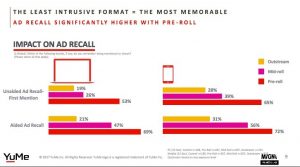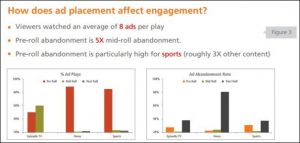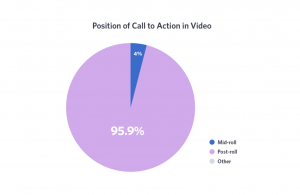Advertisements are the backbone of the marketing industry. Radio, television, billboards, newspapers, those pre-, pre- trailers at the movie theaters: anything you can see, read, or hear is embedded with an advertisement. I’m sure you’ve noticed your social media over the years gradually filling with ads. But with so many ad placement options, what is the most effective choice for your company and for your social video campaign?
We all know that video marketing is the key to any good campaign, but the next step is how you show off all that hard work. Where do you put that video advertisement so you get the most bang for your buck? Pre-roll ads like Youtube, mid-roll like Facebook or even post-roll – each have their benefits as well as their pitfalls.
The Oldie but a Goodie
Pre-roll is the forefather of digital video advertisements. It is a tried and true model of video ad placement. Running an advertisement before the desired content is the practical course of action, as the audience is still engaged and interested in the forthcoming content. Pre-roll ad placement accesses consumers while they’re still willing to sit through an advertisement. With this strategy, there is a higher chance the advertisement will be watched at least for a few seconds, if not in its entirety.
In a recent study by IPG Media Lab and YuMe, pre-roll video ad formats were found to resonate better with mobile users compared to mid-roll and outstream executions. Only 17% of participants claimed that pre-roll ads interrupt the user experience.

One of the larger benefits that pre-roll advertising brings is its ability to build brand awareness. Showcasing the brand or the product before the actual content means that the consumer is still locked in and curious, making them open to advertisements from brands unknown to them.
YuMe found that “pre-roll ads are extremely effective across several metrics, including brand association, brand engagement, brand favorability and intent to purchase.”
Youtube is a great example of a platform that is extremely adept at using pre-roll ads for the companies and brands advertising on their site. The use of this form of ad placement has brought YouTube, its parent company Google, and the advertisers themselves a great deal of revenue. But with the ability to skip through the advertisement after only five seconds, based on the Truview method, does pre-roll placement allow for the most viewership or revenue?
According to Local Solutions, “Brands that created ads and video that were viewed for less than one second still saw increased ad recall, brand awareness and even purchase consideration.” So even if the TruView Method allows for the viewer to skip an ad after only five seconds, that small amount of time is still more than enough to increase brand awareness and even direct revenue from purchases .
When Pre-Roll Doesn’t Work
However, pre-roll ad placement is incompatible with the Facebook newsfeed algorithm. That is a hard hit on both Facebook and the advertisers who want to take advantage of the social platform’s far reaching network and popularity. While pre-roll videos might be the least disruptive, they don’t exactly inspire people scrolling through Facebook to stop and watch an ad, before getting a glimpse of the actual video content.
The Newcomer
Now, it’s clear that a pre-roll ad is perfect for platforms like Youtube. But, due to Facebook’s timeline setup, it has been as struggle for the platform’s executives to figure out how to monetize the popular videos on the site. Facebook is a passive discovery mechanism, which means the news feed would be full of pre-roll ads and not the video itself. With a side full of advertisements autoplaying all at once, it becomes impossible to keep users invested in the site’s content. So, do you change the format of the platform or do you change the ad placement?
Enter mid-roll placement: the solution to Facebook’s problem. But is it truly lucrative enough to justify its usage?
Local Solutions writes that “[by] many measurements mid-roll advertising can offer some pretty solid returns. Mid-roll ads enjoy a higher completion rate than both pre- and post-roll ads. Viewers have already watched some of the video content; if they make it to a mid-roll ad, it means they have remained engaged through roughly half of the video. Because such a large chunk of video remains, they are more willing to be patient.”

Engagement is what keeps a viewer patient enough to sit through a fifteen second ad that has just disrupted their video. However, many people have protested the mid-roll ad due to inelegant placement – advertisements cutting abruptly into the video, or breaking the flow of a conversation. Since implementing mid-roll advertisements, Facebook has already doctored the formula to make users happier and less caught off guard by the advertisements.
Previously, videos had to be only ninety seconds long to qualify for an ad break, and the ad could be inserted as soon as twenty seconds into a video. Facebook heard the cry of the annoyed public and has now transitioned to using a three-minute minimum on videos with a mid-roll ad break.
Mid-Roll and Audience Engagement
One other problem with mid-roll ads is that an audience member may decide that they don’t want to watch the video anymore, meaning they never make it to the advertisement. Recode argues that “the problem is that the mid-rolls, people don’t tend to get to or they switch off as soon as they go to and just move onto the next thing.”
While mid-roll ad placement fixes the problem for Facebook’s newsfeed algorithm, would it still work for other websites and social platforms? More importantly, is it worth it for brands and companies to spend money on an ad no one might even watch?
The Underdog
It seems counterintuitive to put your ad after the main content, but surprisingly, post-roll ad placement can go a long way. However, you have to use this placement strategically. Post-roll works best in some very specific circumstances. For instance, this ad placement works great as a call-to-action following branded content. If you want to stir the fire within your audience, to make them truly feel the call- to- action, then post-roll is the best option.

If you want to make sure your post-roll ad is a success, there are a few techniques you can try. For example, adding music to the end of a video that transitions into your post-roll ad will keep the audience engaged for those extra few seconds. Keeping that interest flowing is key to the post-roll placement. That being said, since it does require such specific circumstances, post-roll may not be the go-to placement for most content.
The Decision
Each of these video ad placements have their benefits and their pitfalls. Ad placement is a personalized choice and the decision should be made based on the content and feel of each advertisement.
Pre-roll is a great form of ad placement for increased brand awareness, purchase consideration and ad recall as a whole. It is an ad-placement that uses audience engagement with the yet to be viewed desired content, to their advantage, and in turn is a proven method of lucrative video advertising.
Mid-roll ad placement is right for for an advertisement if the platform has a more passive discovery mechanism, like Facebook. Mid-roll ad placement also has a higher completion rate than pre-roll or post-roll, which makes it a good choice for any company who wants, or even needs the audience to watch the whole ad. That means your viewers will get the most out of what the brand or company has put into the ad.
Last but not least is post-roll. Post-roll is the best option if you have a call-to-action within the advertisement. If you really want to make your audience feel that immediate response, then post-roll is the the best placement for the advertisement.
While each ad placement has some specific strategies that are most compatible with the format, there is no one size fits all method. What works for one ad campaign may not work for another, and it is up to the marketers to understand the best placement for each advertisement and each brand.
And, ultimately, ad placements are most effective when the video itself is well-made and optimized for its specific distribution platform. In our current attention economy, viewers are overstimulated, making it even more difficult to engage an audience in your content – no matter how it’s placed. So before you rush to distribution, set your ad up for success with a skilled video team that can deliver a compelling story.
Updated on February 12, 2020.
Maya Mandell, Video Production and Marketing at Green Buzz Agency. Emily Herman contributed to this post.
